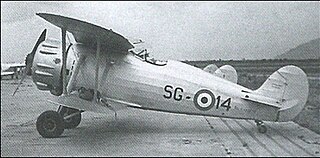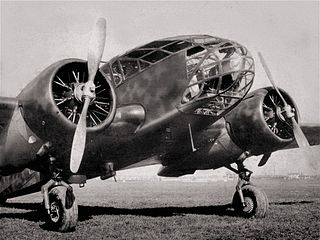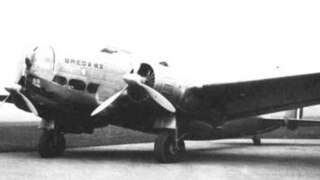
The Breda Ba.88 Lince ("Lynx") was a ground-attack aircraft used by the Italian Regia Aeronautica during World War II. Its streamlined design and retractable undercarriage were advanced for the time, and after its debut in 1937 the aircraft established several world speed records. However, when military equipment was installed on production examples, problems of instability developed and the aeroplane's general performance deteriorated. Eventually its operational career was cut short, and the remaining Ba.88 airframes were used as fixed installations on airfields to mislead enemy reconnaissance. It represented, perhaps, the most remarkable failure of any operational aircraft to see service in World War II.

The CANT Z.1007 Alcione (Kingfisher) was an Italian three-engined medium bomber, with wooden structure. Designed by Filippo Zappata, who also designed the CANT Z.506 it had "excellent flying characteristics and good stability" and was regarded by some as "the best Italian bomber of World War II" although its wooden structure was easily damaged by the climate, as experienced in North Africa and in Russia. It was used by the Italian Regia Aeronautica, Italian Co-Belligerent Air Force, Aeronautica Nazionale Repubblicana and Luftwaffe during World War II.

The Breda Ba.65 was an Italian all-metal single-engine, low-wing monoplane used by Aviazione Legionaria during the Spanish Civil War and Regia Aeronautica in the first half of World War II. It was the only Italian ground-attack aircraft that saw active service in this role. It saw service almost exclusively in the North African and Middle-Eastern theatre. In addition to more than 150 aircraft operated by the Italian forces, a total of 55 were exported and used by the air forces of Iraq, Chile and Portugal.

The AUT.18 was a prototype fighter aircraft developed in Italy by Aeronautica Umbra shortly before the outbreak of World War II. It was designed in 1934 by Felice Trojani, who at that time was collaborating with Umberto Nobile on the Arctic flights of the airships Norge and Italia. The aircraft's designation came from initials of the manufacturer, the surname of the designer, and the aircraft's wing area, the sole prototype receiving the serial no. M.M.363.

The Fiat CR.25 was an Italian twin-engine reconnaissance-fighter aircraft which served in small numbers for the Regia Aeronautica during World War II.

The Breda Ba.64 was an Italian single-engine ground-attack aircraft used by the Regia Aeronautica during the 1930s.

The Meridionali Ro.37 Lince was a two-seater Italian reconnaissance biplane, a product of the Industrie Meccaniche Aeronautiche Meridionali (IMAM) company. It appeared in 1934 and had a composite structure of wood and metal. The aeroplane first saw operational duty in the Second Italo-Ethiopian War (1935–1936) and Spanish Civil War (1936–1939), and during the Second World War it saw duty on almost all fronts, except for Russia and the English Channel. It followed the Ro.1 as the main reconnaissance aircraft for the Italian Army.

The CRDA CANT Z.1018 Leone (Lion) was an Italian medium bomber of the 1940s.

The Breda Ba.201 was an Italian dive bomber designed during World War II, that never entered production.

The Caproni Vizzola F.5 was an Italian fighter aircraft that was built by Caproni. It was a single-seat, low-wing cantilever monoplane with retractable landing gear.

The IMAM Ro.41 was an Italian light biplane fighter aircraft, serving in the Regia Aeronautica in the 1930s-1940s, mainly as a trainer.

The Piaggio P.119 was an Italian experimental fighter of World War II. It had a relatively novel layout, with a "buried" radial engine mounted mid-fuselage. Only a single prototype was built before the Armistice between Italy and the allied armed forces, which ended the project.
The Piaggio P.32 was an Italian medium bomber of the late 1930s, produced by Piaggio, and designed by Giovanni Pegna. It was a modern design for its time, but was a failure due to lack of powerplants commensurate with its high wing loading.

The IMAM Ro.51 was an Italian fighter aircraft that first flew in 1937. It was designed for the 1936 new fighter contest for the Regia Aeronautica, with practically all the Italian aircraft builders involved.

The Caproni Ca.311 was a light bomber-reconnaissance aircraft produced in Italy prior to and during World War II.

The Caproni Ca.355 Tuffo was a low-wing single-engine dive bomber, designed and built by the Italian Caproni company in 1941, which never proceeded beyond a single prototype. Derived from Ca.335 Mistral, the Ca.355 was proposed to equip the Regia Aeronautica, but it was found to offer little advantage over the German Junkers Ju 87 "Stuka" and the project was abandoned.

The Caproni CH.1 was a single-seat biplane fighter, a single example of which was produced as a prototype in Italy in 1935.

The Caproni Vizzola F.4 was an Italian fighter aircraft prototype that was designed in 1937 and built from 1939. It was a single-seat, low-wing cantilever monoplane with retractable landing gear.

The Breda Ba.82 was an Italian medium bomber prototype of the late 1930s; it was designed and built by the Breda company.

The IMAM Ro.58 was an Italian twin-engined, two-seat monoplane heavy fighter and attack aircraft, a development of the IMAM Ro.57. First flown in May 1942, it was considered a general improvement over its predecessor, mainly due to the substitution of higher power Daimler-Benz DB 601 engines for the Fiat A.74 engines used on the Ro.57. Initially it had many problems and during the maiden flight only the proficiency of the test pilot, Adriano Mantelli, saved the plane.























